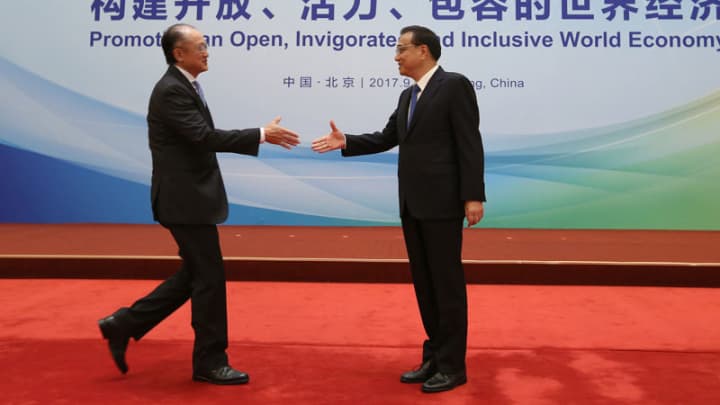
WASHINGTON — Most World Bank lending to China aligns with the bank’s existing policy on how it lends to wealthier countries — but some lending doesn’t, according to a new report from the Center for Global Development.
“As we assessed the whole portfolio, big buckets made sense, but there were gaps — projects not supporting western China or to low-income provinces.”
— Scott Morris, one of the report’s authors and senior fellow and director, US Development Policy InitiativeThe report, released Thursday, examines how lending to China fits into the bank’s framework for engaging with graduation eligible countries, which was adopted as part of the capital increase process last year. The 2018 agreement limits the share the International Bank for Reconstruction and Development can allocate to countries that are above the graduation threshold, adjusted the pricing on lending to those countries, and laid out principles for how IBRD should engage in those countries.
The principles for graduation discussion income countries in the capital agreement allow lending for efforts that enable graduation, including capacity building initiatives, and support for global public goods.
Since the fiscal year 2016, IBRD has made more than $7.8 billion in commitments to China, making China one of the bank’s largest borrowers, according to the report. It is not the bank’s wealthiest borrower, but it is above the graduation discussion income threshold of $6,895, and the continued levels of bank lending to the country, that has in its own right become a large lender to other countries, has raised some concerns.
China’s borrowing from the World Bank was a key point of discussion ahead of last year’s capital increase and a source of tension between the United States and the World Bank. But whether and how much China should continue borrowing does not have a straightforward answer, said Scott Morris, one of the report’s authors and a senior fellow and director of the US Development Policy Initiative at the Center for Global Development.
While IBRD lending could potentially go to lower-income countries than China, and there is a limit on how much lending it can do in a year, it has to make decisions based on the credit quality of its portfolio. Investments in China are strong and there is no guarantee that IBRD could find enough credit-worthy investments to replace what it is lending to China, he said, adding that stopping to lend to China would make IBRD financially vulnerable, particularly if it happened quickly.
More on Chinese aid:
►Will the World Bank push China's Belt and Road Initiative in the right direction?
There have also been questions about why China, which can get financing elsewhere on similar terms and is a big donor itself, would turn to the World Bank. China is likely motivated by the services, technical expertise, and policy dialogue that comes with the loans, Morris said, adding that the report is meant to inform the policy debate about China and graduation from World Bank lending.
“What we found in taking a close look at the portfolio is broadly reassuring,” Morris said of the fact that China continues to borrow under thematic constraints. But there are some areas that don’t seem to fit the standards or lending to higher income borrowers, per the agreement that accompanied last year’s capital increase, he noted.
CGD looked at the lending alignment to the new 2018 policies, along with past China country partnership strategies, which govern how IBRD lends to China, the most recent of which governed activities through 2016. The strategies said that funding should focus on the less-developed western and inland provinces and on environmental objectives.
The analysis found that about 83 percent of the lending by volume in the deals went to non-coastal provinces, but only 58 percent of the lending went to provinces below the graduation discussion income threshold.
“If IBRD lending were designed to be strictly focused on the poorer provinces as a path toward graduation, then actual lending appears to have fallen well short,” the report states.
About 44 percent of the lending to China is related to global public goods — particularly climate mitigation — or designated strictly as capacity building, according to the report, which said that this “suggests weak alignment with the 2018 principles.” A broader interpretation of capacity building, including an analysis of the lending to the poorest provinces that need more assistance, paints a more favorable picture of the alignment, Morris said.
“As we assessed the whole portfolio, big buckets made sense, but there were gaps — projects not supporting western China or to low-income provinces. A tighter country strategy would not allow [those] investments to get through,” he said.
To help ensure that there are not projects that do not align, the report suggests that the World Bank do a better job of labeling projects and establish a clear framework for evaluating loans to ensure that they fit with the bank’s policy objectives.
While the new policy should guide decision-making and investment decisions should be evaluated based on those guidelines, but Morris said that major new procedures likely aren’t necessary.




